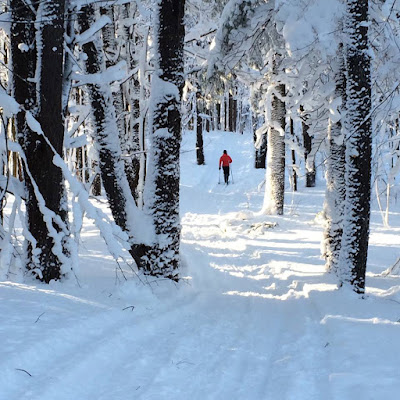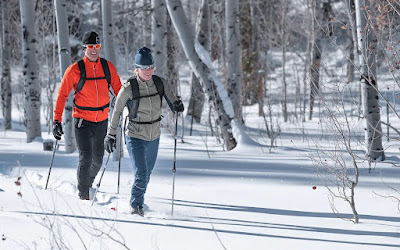
He’s the picture of concentration and resolve, ready for action.
But the ground the little skier stands on is depicted by a prominent horizontal line across the bottom of the scene. Except at one point where just the tips of his skis hang out over a moderately steep, one-foot drop-off.
The headline reads: Ski Minnesota!
GRAVITY, SCHMAVITY
The problem with alpine—downhill—skiing in Minnesota is that there’s just too much gravity and no place for it to go. For a decent run, you need at least 500 feet of vertical drop, which very few slopes in the state have. (By comparison, better ski resorts in Vermont boast of a couple thousand feet of drop; in the Canadian and U.S. Rockies, some have nearly a vertical mile.)
That’s just one of the reasons I love Nordic—cross-country—skiing. You don’t need no stinking’ mountain. And there are also the facts that it’s kinder to one’s body, costs far less and provides its own kind of patient, level-headed beauty.
In downhill ninety-five percent of the effort goes into controlling the force of gravity. In cross-country, nearly all your energy’s devoted to creating your own force, propelling yourself, mostly horizontally, from point A to point B.
It’s like the difference between skydiving and flying, white-water rafting and lake canoeing, an eagle and a swan.
GET A GRIP
Alpine skis are designed essentially to do two things: slide on snow with as little friction as possible, and carve turns. Nordic skis—specifically classic-style cross-country skis—also have to glide, but only in one direction. They employ one of several devices to make them slide forward easily, but grip going backward.
That grip is achieved in one of several ways: One is the application of special waxes, each formulated to grab the snow under certain temperature and snow texture conditions. There are also a couple of mechanical devices to accomplish the same grip-and-glide. They entail either a fish-scale texture embossed into the middle third of the skis’ bottoms, or “skins,” strips of real or synthetic mohair, which has a distinct grain.
For a classic-style cross-country skier the motion is very much like that of walking; there are distinct strides. As you extend one ski in front of you, you transfer your weight to the other ski and push it back. To maximize the amount of grip you get on the snow with that pushing ski, you add a downward force with a subtle stomp or “kick” off the toe of your boot. That makes whatever grip device you’re using bite into the snow.
That constant heel-toe alternation means cross-country ski boots have to be very different from the rigid, cast-like grip of alpine boots. Cross-country boots are much lighter and more flexible, their only point of attachment to the skis at the
very toe.
Cross-country’s more constant, repetitive nature
allows one to escape into the rhythms of one’s
own breathing and heartbeat.
RHYTHM METHOD
Downhill skiing employs the large muscles of the thighs and buttocks primarily as shock absorbers. There are G forces involved. And the poles are used mostly for balance and pivoting.
But classic-style Nordic skiing actually employs more muscle groups and burns more calories than downhill.* One reason for this is that the poles, driven by one’s arms and shoulders, are vital to providing propulsion with every stride.  Besides the physical aspects of the two types of skiing, there are important mental/spiritual differences. While alpine skiing may give one more of an adrenaline rush, Nordic skiing’s benefit, the regular pulse of push and glide, and the whispery sounds, is more of a meditative or spiritual one.
Besides the physical aspects of the two types of skiing, there are important mental/spiritual differences. While alpine skiing may give one more of an adrenaline rush, Nordic skiing’s benefit, the regular pulse of push and glide, and the whispery sounds, is more of a meditative or spiritual one.
Skiing downhill, you’re constantly navigating around obstacles and changes in terrain. Cross-country’s more constant, repetitive nature allows one to escape into the rhythms of one’s own breathing and heartbeat.
The older I get, the brittler my bones, the more I love the sport’s serenity. There’s nothing quite like the sense of oneness with one’s body and with Nature when you’ve skied far ahead of your group and stop to wait for them. You feel fully alive, in perfect balance, fully immersed in wonder.
A GOOD WINTER
If the trail is groomed, you have nice, neat grooves to guide those long, narrow skis. So most hills are a breeze, at least going down. But if there happens to be a tight curve at the bottom, or if, God forbid, folks have decided your ski track is a nice place to snowshoe or walk their St. Bernard, all bets are off. If you’re out of practice, your skis can easily jump the tracks and send you careening into the woods.
If there are no groomed tracks, you have to break trail, and that’s a whole different animal. Kind of a combination between skiing and snowshoeing, it’s a challenge to one’s stamina, balance and patience. But the reward is knowing that each subsequent skier who comes along will benefit from your labors.
It’s all part of sport of Nordic—cross-country—skiing. If you haven’t tried it this is a good winter for it, at least here in Minnesota. With over a foot of accumulated base and an inch or two of new snow every few days, and very few below-zero days, conditions have been ideal.
If you’re ready to jump—or should I say slide—in, local ski shops should be discounting their cross-country ski gear soon. If you’re not ready, equipment’s available to rent at many ski areas, public parks and ski shops. Either way, I hope to see you out there soon!
* DOWNHILL SKIING – A person weighing 150 pounds can expect to burn 360-570 calories in an hour of skiing. Downhill can be an intense workout for your core and legs, especially as you hit moguls, deeper powder, or jumps.
CROSS-COUNTRY SKIING – A 150-pound person will burn 500-650 calories per hour. Cross-country is a slow but constant burn, keeping your body working every step of the way.
“Downhill vs. Cross Country: The Ski-Booted Battle” – by Brian Hanford, Nov. 30, 2015 – EatFitFuel.com







0 comments:
Post a Comment
Thanks for visiting One Man's Wonder! I'd love to hear your comments on this post or my site in general.
And please stay in touch by clicking on "Subscribe" below.